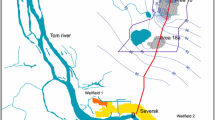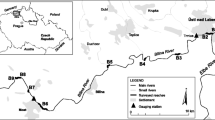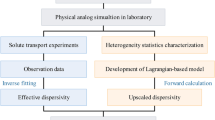Abstract
Development of heterogeneity model of layered sandy-clay formation and impact of this model on transport is considered. The lithological data of more than 250 wells that captured 300 meters formation at the investigated area of 40 km2 are used for model of heterogeneity construction. Two models of heterogeneity were developed with using these well data: TP/MC model based on 3D Markov chain simulation for four hydrofacies and 2D kriging interpolation of thicknesses of elementary lithological layers. Simulation of conservative transport by particle tracking algorithm shows that horizontal transport along layers is similar for both models. The main difference is in vertical transport cross formation bedding. The kriging interpolation model gives more conservative results than TP/MC model due to larger characteristic horizontal length of layers in the kriging model. As the result vertical effective hydraulic conductivity of formation is in two times larger and the first particle arriving time is in four times faster in TP/MC model.
Similar content being viewed by others
References
Bishop, C.E., Wallace, J., and Lowe, M., Recommended Septic Tank Soil-Absorption-System Densities for Cache Valley, Cache County, Utah, Report of Investigation. Utah Geological Survey. Division of Utah Department of Natural Resources, 2007, vol. 257.
Bulynnikova, A.A. and Surkov, V.S., Geologicheskoe stroenie i perspektivy neftegazonosnosti yugo-vostochnoi chasti Zapadno-Sibirskoi nizmennosti (Geological Structure and Oil-and-Gas Bearing Prospects of the Southeastern Part of West Siberia), Moscow: Gostoptekhizdat, 1962.
Carle, S.F. and Fogg, G.E., Transition Probability-Based Indicator Geostatistics, Math. Geol., 1996, vol. 28, no. 4, pp. 453–477.
Carle, S.F. and Fogg, G.E., Moceling Spatial Variability with One- and Multi-Dimensional Markov Chains, Math. Geol., 1997, vol. 29, no. 7, pp. 891–918.
Carle, S.F., T-PROGS: Transition Probability Geostatistical Software, Univ. of California, 1998.
Chernyaev, E.V., Koshkarev, V.L., Kolmakova, O.V., et al., Geologic-Geophysical Model of the Seversk Area, Izv. Tomsk. Politekh. Univ., 2002, vol. 305, no. 6, pp. 414–433.
Chiang, W.H. and Kinzelbach, W., 3D-Groundwater Modeling with PMWI, Berlin: Springer, 2001.
Dai, Z., Wolfsberg, A., Lu, Z., and Ritzi, R.J., Representing Aquifer Architecture in Macrodispersivity Models with An Analytical Solution of the Transition Probability Matrix, Geophys. Res. Lett., 2007, vol. 34, no. 6, p. L20406.
Dubrule, O., Geostatistics for Seismic Data Integration in Earth Models, Zeist: EAGE, 2002.
Elfeki, A. and Dekking, M., A Markov Chain Model for Subsurface Characterization: Theory and Applications, Math. Geol., 2001, vol. 33, no. 5, pp. 569–589.
Engdahl, N.B., Vogler, E.T., and Weissmann, G.S., Evaluation of Aquifer Heterogeneity Effects on River Flow Loss Using a Transition Probability Framework, Water Resour. Res., 2010, vol. 46, p. 13.
Falivene, O., Cabrera, L., Munoz, J.A., et al., Statistical Grid-Based Facies Reconstruction and Modelling for Sedimentary Bodies. Alluvial-Palustrine and Turbiditic Examples, Geologica Acta, 2007, vol. 5, no. 3, pp. 199–230.
Gol’bert, A.V., Osnovy regional’noi paleoklimatologii (Fundamentals of Regional Paleoclimatology), Moscow: Nedra, 1987.
Koltermann, C.E. and Gorelick, S.M., Heterogeneity in Sedimentary Deposits. A Review of Structure-Imitating, Process-Imitating, and Descriptive Approaches, Water Resour. Res., 1996, vol. 32, no. 9, pp. 2617–2658.
Pinus, O.V. and Pairazyan, K.V., The Peculiarities of Geological Modeling of Productive Beds of Fluvial Origin, Geol. Nefti Gaza, 2008, no. 1, pp. 25–30.
Podobina, V.M., Foraminifery, biostratigrafiya verkhnego mela i paleogena Zapadnoi Sibiri (Foraminifera and Biostratigraphy of Upper Cretaceous and Paleogene in West Siberia), Tomsk: Tomskii gosudarstvennyi univ., 2009.
Pozdniakov, S.P. and Tsang, S.F., A Semianalytical Approach To Spatial Averaging of Hydraulic Conductivity in Heterogeneous Aquifers, J. Hydrology, 1996, vol. 216, nos. 1–2, pp. 78–98.
Pozdniakov, S.P., Bakshevskaya, V.A., Zubkov, A.A., Danilov, V.V., Rybalchenko, A.I., and Tsang, C.-F., Modeling of Waste Injection in Heterogeneous Sandy Clay Formation, in Underground Injection Science and Technology, Amsterdam: Elsevier, 2005, pp. 203–218.
Proce, C.J., Ritzi, R.W., Dominic, D.F., and Dai, Z., Modeling Multiscale Heterogeneity and Aquifer Interconnectivity, Ground Water, 2004, vol. 42, no. 5, pp. 658–670.
Ritzi, R.W., Dominic, D.F., Slesers, A.J., et al., Comparing Statistical Models of Physical Heterogeneity in Buried-Valley Aquifers, Water. Res. Res, 2000, vol. 35, no. 11, pp. 3179–3192.
Rybal’chenko, A.I., Pimenov, M.K., Kostin, P.P., et al., Glubinnoe zakhoronenie zhidkikh i radioaktivnykh otkhodov (Deep Burial of Liquid and Radioactive Waste), Moscow: IzdAT, 1994.
Sivakumar, B., Harter, T., and Zhang, H., A Fractal Investigation of Solute Travel Time in a Heterogeneous Aquifer: Transition Probability: Markov Chain Representation, Ecol. Modell., 2005, vol. 182, nos. 3–4, pp. 355–370.
Sun, A.Y., Ritzi, R.W., and Sims, D.W., Characterization and Modeling of Spatial Variability in a Complex Alluvial Aquifer: Implications on Solute Transport, Water. Resour. Res., 2008, vol. 44, p. 16.
Weissmann, G.S. and Fogg, G.E., Multi-Scale Alluvial Fan Heterogeneity Modeled with Transition Probability Geostatistics in a Sequence Stratigraphic Framework, J. Hydrology, 1999, vol. 226, pp. 48–65.
Weissmann, G.S., Carle, S.F., and Fogg, G.E., Three-Dimensional Hydrofacies Modeling Based on Soil Surveys and Transition Probability Geostatistics, Water Resour. Res., 1999, vol. 35, no. 6, pp. 1761–1770.
Yong, Z. and Fogg, G.E., Simulation of Multi-Scale Heterogeneity of Porous Media and Parameter Sensitivity Analysis, Sci. China, Ser. E: Technol. Sci., 2003, vol. 46, no. 5, pp. 459–476.
Author information
Authors and Affiliations
Corresponding author
Additional information
Original Russian Text © S.P. Pozdniakov, V.A. Bakshevskaya, I.V. Krohicheva, V.V. Danilov, A.A. Zubkov, 2012, published in Vestnik Moskovskogo Universiteta. Geologiya, 2012, No. 1, pp. 40–48.
About this article
Cite this article
Pozdniakov, S.P., Bakshevskaya, V.A., Krohicheva, I.V. et al. The influence of conceptual model of sedimentary formation hydraulic heterogeneity on contaminant transport simulation. Moscow Univ. Geol. Bull. 67, 43–51 (2012). https://doi.org/10.3103/S0145875212010097
Received:
Published:
Issue Date:
DOI: https://doi.org/10.3103/S0145875212010097




